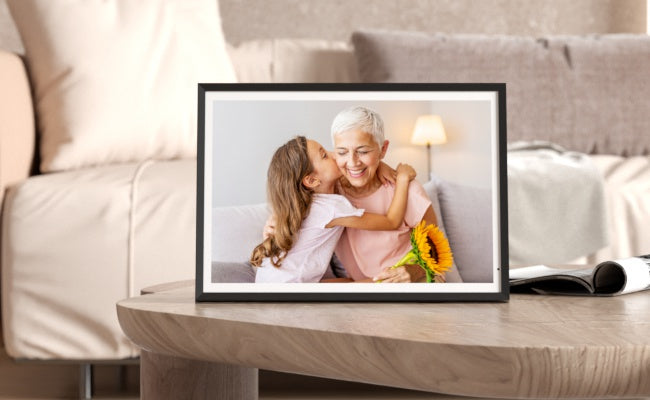The Complete Guide to Textured Picture Frames: Adding Depth and Dimension to Your Walls
When it comes to displaying your most cherished photographs and artwork, the frame you choose can make all the difference. While smooth, traditional frames have their place, textured picture frames offer something extraordinary: they add depth, visual interest, and a tactile quality that transforms ordinary wall displays into captivating focal points.
Textured frames aren't just decorative borders—they're an extension of the art itself. Whether you're framing family photos, fine art prints, or cherished memories, understanding how texture influences the overall presentation will help you create displays that truly stand out.
What Makes Textured Picture Frames Special
A textured photo frame differs from standard frames through its surface treatment. Rather than presenting a flat, uniform appearance, these frames feature raised patterns, carved details, distressed finishes, or applied materials that create visual and physical dimension. The texture can range from subtle grain patterns that catch light at different angles to bold, sculptural elements that become art pieces in their own right.
The beauty of frame texture lies in its versatility. A heavily textured baroque-style frame might complement classical oil paintings or vintage family portraits, while a frame with subtle linen texture could be perfect for contemporary photography or minimalist artwork. The key is matching the texture's character to both the artwork and the surrounding space.
Types of Texture in Picture Frames
Understanding the different texture categories helps you make informed decisions for your framing projects. Wood grain textures remain timeless classics, with options ranging from smooth, polished finishes that reveal natural patterns to rough-hewn surfaces that celebrate rustic charm. Reclaimed wood frames often feature natural weathering, knots, and age marks that tell their own stories.
Ornate carved textures appeal to those who appreciate traditional elegance. These frames showcase intricate patterns—from delicate floral motifs to geometric designs—that add formal sophistication to any display. They work beautifully in traditional interiors or when you want to elevate the perceived value of the framed piece.
Distressed and aged textures have gained popularity for their ability to add character instantly. These frames might feature deliberate cracking, chipping, or color variations that create an heirloom appearance. They're particularly effective for vintage photographs, shabby chic interiors, or when you want to soften the formality of a display.
Fabric and upholstered textures bring unexpected softness to framing. Linen-wrapped frames offer subtle sophistication, while velvet or suede options add luxury and warmth. These work exceptionally well in bedrooms, dressing rooms, or anywhere you want to create an intimate atmosphere.
Metal textures provide industrial or contemporary appeal. Hammered finishes, brushed surfaces, or oxidized patinas on metal frames create interesting plays of light and shadow while offering durability and modern aesthetic appeal.
My Personal Experience with Textured Frames
Last spring, I was redecorating my living room and faced a common dilemma: I had a collection of family vacation photos that felt flat and uninspiring in their basic black frames. After visiting a local frame shop, I discovered weathered barnwood frames with deep grain patterns and natural variations in color. The transformation was remarkable. Those same vacation photos suddenly felt like curated gallery pieces. The warm, rustic texture of the frames created a cohesive story that connected the images while adding a layer of nostalgia that perfectly captured the spirit of our family adventures. Guests consistently comment on the display, and it taught me that the right texture doesn't just frame a photo—it enhances the entire memory.
Choosing the Right Texture for Your Space
Selecting appropriate texture requires considering multiple factors. Start with your interior design style. Modern and minimalist spaces often benefit from frames with subtle, refined textures—think smooth wood grain or brushed metal. Traditional and classical interiors welcome ornate carved details and rich wood finishes. Rustic and farmhouse styles embrace distressed wood, weathered finishes, and natural imperfections.
The artwork itself should guide your texture choice. Delicate watercolors might be overwhelmed by heavy, bold textures, while large canvas prints can handle more dramatic frame treatments. Black and white photography often looks stunning in frames with silver or gray-toned textures, while colorful artwork might benefit from neutral textured frames that don't compete for attention.
Room function matters too. High-traffic areas benefit from durable textures that hide minor wear, while formal spaces like dining rooms can showcase more delicate or ornate textures. Bedrooms and private spaces offer opportunities to experiment with softer, fabric-based textures that create comfort and intimacy.
Practical Considerations for Textured Frames
Maintenance varies by texture type. Smooth textures are easiest to clean with simple dusting, while deeply carved or distressed frames require more careful attention to prevent dust buildup in crevices. Fabric textures may need occasional vacuuming with upholstery attachments, while metal textures might require specific cleaning products to maintain their finish.
Weight becomes a factor with heavily textured frames, particularly those with thick carved details or multiple material layers. Ensure your wall anchors and hanging hardware can support the additional weight. Professional installation may be worthwhile for large or heavy textured frames.
Cost typically increases with texture complexity. Hand-carved frames command premium prices, while simpler applied textures or finishes offer more budget-friendly options. Consider where you're willing to invest: statement pieces in prominent locations might warrant higher-end textured frames, while secondary displays could use more economical options.
Creating Cohesive Gallery Walls with Texture
Gallery walls present exciting opportunities for playing with texture. You can create unity through consistent texture across all frames, or intentionally mix textures for an eclectic, collected-over-time appearance. When mixing textures, maintain connection through color palette, finish type, or scale to avoid visual chaos.
Layering textures adds sophistication. Combine a textured frame with textured matting, or pair smooth frames with textured wall surfaces. These layers create depth that makes displays more engaging and dynamic.
Trends and Timeless Choices
Current trends favor natural, organic textures that bring warmth and authenticity to interiors. Reclaimed wood, natural fiber wraps, and handcrafted finishes reflect the broader movement toward sustainable, artisanal design. However, timeless textured frames—classic carved wood, elegant grain patterns, and refined metal finishes—never go out of style and represent safe investments for long-term display.
The key to successful textured frame selection lies in balancing personal preference with practical considerations. A frame that resonates with you personally while complementing your artwork and space will always feel right, regardless of trends. Textured picture frames transform the act of displaying images from purely functional to genuinely artistic, turning your walls into curated expressions of your aesthetic vision and personal story.






